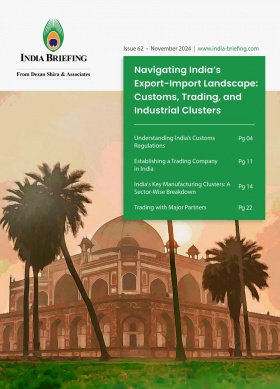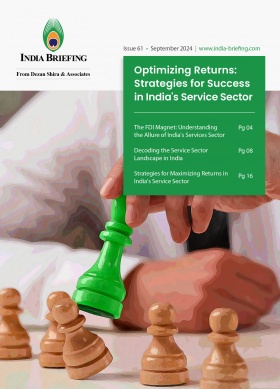How the PM Gati Shakti National Master Plan is Advancing India’s Infrastructure Sector
The PM Gati Shakti National Master Plan (Gati Shakti NMP) has transformed India’s infrastructure landscape with a coordinated, efficient, and integrated approach. Announced by PM Narendra Modi on October 13, 2021, Mission Gati Shakti is a transformative infrastructure initiative with a proposed investment of INR 100 trillion. It integrates 16 ministries and national schemes like Bharatmala, Sagarmala, UDAN, and various industrial corridors, creating a unified framework for roadways, railways, ports, waterways, and airports. The plan addresses inefficiencies in India’s traditionally compartmentalized infrastructure development approach.
In a recent report, Morgan Stanley commended India’s Gati Shakti NMP for its transformative impact on the nation’s infrastructure development. The report projects that India’s infrastructure investment will increase from 5.3 percent of GDP in fiscal year 2024 to 6.5 percent by fiscal year 2029, representing a robust compound annual growth rate (CAGR) of 15.3 percent. This surge is expected to result in cumulative spending of US$1.45 trillion over the next five years, fostering sustained, high productive growth and boosting investment rates.
How the Gati Shakti Scheme works
Gati Shakti relies on a (Geographic Information System) GIS-based platform by BISAG-N (The Bhaskaracharya National Institute for Space Applications and Geo-informatics), incorporating 1,450+ data layers, including satellite imagery from the Indian Space Research Organisation (ISRO). It enables real-time, synchronized planning, and decision-making across ministries, reducing delays and inefficiencies. Governance is ensured through the Network Planning Group (NPG) and the Empowered Group of Secretaries (EGoS). Tools like electronic Detail Route Survey (eDRS) and “Go/No-Go” area assessments enhance planning efficiency, cutting survey times and optimizing routes.
Key infrastructure programs, such as Bharatmala (highways), Sagarmala (ports), UDAN (aviation), and inland waterways, are seamlessly integrated into the Gati Shakti NMP. This coordinated approach enhances last-mile connectivity, facilitates the movement of goods and people, and optimizes the use of resources, enabling India to build a robust and efficient logistics network.
Gati Shakti project execution hinges on collaboration between state and central ministries
The Gati Shakti NMP has integrated 44 central ministries and 36 states/union territories (UTs), incorporating 1,614 data layers to enhance infrastructure planning and coordination. To ensure data accuracy, key infrastructure ministries have established Standard Operating Procedures (SOPs) within a three-tier framework. SOPs have been finalized for eight infrastructure ministries and 15 social sector ministries, while development efforts are ongoing for other ministries and states/UTs. A ‘Compendium on PM Gati Shakti National Master Plan,’ prepared by the Department for Promotion of Industry and Internal Trade (DPIIT), provides detailed guidelines on data management and stakeholder responsibilities.
Achievements under the Gati Shakti Scheme
Among its achievements is the evaluation of 208 major infrastructure projects valued at INR 15.39 trillion, adhering to PM Gati Shakti principles. Furthermore, 434 projects across three railway economic corridors—Energy, Mineral and Cement Corridors, High Traffic Density Corridors, and Rail Sagar Corridors—have been reviewed and submitted to the Prime Minister’s Office (PMO) for consideration.
The success of PM Gati Shakti has caught the attention of several countries, including Nepal, Bangladesh, and Senegal, which are keen to replicate aspects of the platform. This global interest highlights India’s emergence as a model for infrastructure development among emerging economies.
In just three years, PM Gati Shakti has delivered significant milestones, as discussed below.
Infrastructure development
- Over 8,891 km of roads and 27,000 km of railway lines planned.
- A 300km coastal corridor in Gujarat streamlined, cutting the number of NoC (No Objection Certificate) permissions from 28 to 13, boosting tourism and connectivity.
- Leh to Kaithal Green Energy Corridor optimized for renewable energy transmission.
Identifying and resolving gaps
- Addressed 156 critical gaps in coal, steel, and food distribution sectors.
- Enhanced last-mile connectivity for key economic zones.
Technological integration
- Leveraged GIS with 1,600+ data layers for real-time decision-making.
- Enabled faster project approvals and reduced delays, ensuring on-time and within-budget completion.
State initiatives
- Gujarat reduced clearances for its coastal corridor, UP planned new schools in underserved areas, and Goa developed disaster management plans using NMP.
Cross-sector collaboration
- Ministries leveraged the NMP to address healthcare, skill development, and rural development gaps.
Next steps
Private sector participation
Looking ahead, the Indian government is exploring private sector participation in PM Gati Shakti. By granting access to non-sensitive data, the initiative aims to foster a collaborative environment through public-private partnerships (PPP). This move is expected to bring in additional resources, technical expertise, and innovative solutions, further accelerating project implementation.
District-level project administration
Additionally, the initiative plans to expand to district-level projects through the development of a District Master Plan portal. This portal will empower local authorities to identify infrastructure gaps and implement region-specific solutions, ensuring that the benefits of infrastructure development reach every corner of the country.
Conclusion
PM Gati Shakti is more than just an infrastructure plan—it is a vision for India’s future. By fostering inter-ministerial collaboration, leveraging advanced technologies, and involving the private sector, the initiative is laying the foundation for sustained economic growth and global competitiveness.
As India aims to become a US$5 trillion economy and achieve the Viksit Bharat Vision 2047, PM Gati Shakti will remain a cornerstone of its infrastructure strategy. With its innovative, integrated, and inclusive approach, the scheme is poised to propel India into a new era of development, ensuring that its infrastructure sector becomes a benchmark for the world.
(With inputs from Melissa Cyrill.)
About Us
India Briefing is one of five regional publications under the Asia Briefing brand. It is supported by Dezan Shira & Associates, a pan-Asia, multi-disciplinary professional services firm that assists foreign investors throughout Asia, including through offices in Delhi, Mumbai, and Bengaluru in India. Readers may write to india@dezshira.com for support on doing business in India. For a complimentary subscription to India Briefing’s content products, please click here.
Dezan Shira & Associates also maintains offices or has alliance partners assisting foreign investors in China, Hong Kong SAR, Dubai (UAE), Indonesia, Singapore, Vietnam, Philippines, Malaysia, Thailand, Bangladesh, Italy, Germany, the United States, and Australia.
- Previous Article India’s RoDTEP Scheme for Exporters: Key Extensions and Compliance Updates
- Next Article Quick Commerce Market in India and Key Players








